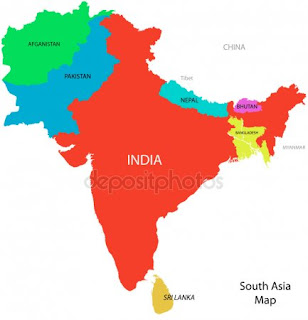South Asian Countries
Many dialects an about talked in South Asia. These dialects share numerous attributes, for example, linguistic structure and vocabulary, yet they are likewise particularly unique. What's more, the majority of the countries of South Asia, aside from the Maldives, have phonetic minorities.
Dialects
In India English and Hindi are the two most usually talked dialects. English, the dialect of the locale's previous provincial bosses, is broadly talked by India's scholarly world class. An endeavor in 1965 to make Hindi, India's most broadly talked dialect, the official national dialect fizzled when individuals from the south fiercely showed against the new law. As a trade off, the Indian government guaranteed to hold English as a national dialect. Other than Hindi and English- - the now assigned national dialects, various different dialects have status as official dialects of the diverse states in India.
In, Pakistan five dialects are for the most part talked. The diagram beneath demonstrates Pakistan's dialects and the percent of individuals who talk every one of them. Note that Urdu, the assigned national dialect, is talked by just 8% of the populace.
In Bangladesh 98% of the general population speak Bangla. In Nepal Nepalese has been assigned the national dialect, however, in excess of twenty distinct dialects are talked there. Ethnic minorities in Nepal keep on trying to pick up government acknowledgment for their specific dialect. In Bhutan, an assortment of dialects is talked. In Sri Lanka, Sinhala is talked by the Sinhalese dominant part and Tamil is talked by the Tamil minority. English is regularly talked in government. In the Maldives the national and authority dialect is Dhivehi. English and some Indian dialects are additionally talked in the Maldives.
Most dialects in South Asia are firmly attached to specific countries, and subsequently, additionally isolate the general population from each other. At the point when individuals don't talk a similar dialect, speaking with each other is frequently troublesome. This absence of correspondence conflicts with solidarity since individuals utilize their dialect as their main methods for communicating their most profound convictions, qualities, and sentiments, which are most much of the time associated with their religious legacies.
Religions
Like dialect, religion has additionally separated the general population of South Asia. The significant religions in the subcontinent are Hinduism, Islam, Sikhism, Buddhism, and Christianity. The diagram beneath demonstrates the diverse religions in South Asia and the percent of the in excess of 1.29 billion individuals who rehearse every one of them.
Most of the general population in South Asia rehearse Hinduism. Hindus have numerous portrayals of God from which they adore. They additionally have numerous blessed sacred texts and prophets. There is no single way to salvation for Hindus. Hindus trust that one's spirit may be renewed a few times previously picking up edification, at which time one's spirit is converged with the infinite powers and is killed. Through its tenet of karma and the standing framework, Hinduism clarifies the disparities in human culture.
The second most rehearsed religion in South Asia is Islam. Islam educates a confidence in just a single god- - Allah. Individuals who hone the Islamic confidence are Muslims. Muslims have one sacrosanct content, the Koran, which was uncovered to God's last prophet, Mohammed. Muslims trust that individuals have one possibility - one life- - to accomplish salvation. Moreover, Islam focuses on the profound fairness and fellowship of all humankind. Photograph: Moslem man perusing the Koran. Photograph © 1999 - www.arttoday.com
Sikhism emerged out of Hinduism as a change of development in the sixteenth century. It focuses on that individuals can escape resurrection by ruminating over God's name. Sikhs trust in the shapeless idea of God and propose that the most ideal approach to salvation is carrying on with a decent family life in view of the standards of work, love, and philanthropy. Sikhs have their own particular arrangement of sacred texts and religious conventions that set them apart from Hindus.
Buddhism is a religion that emerged as a change of development in Hinduism in the fifth century BCE. Its organizer was Siddhartha Gautama, who trusted that affliction was intrinsic in all life. To evade enduring, one must dispense with want by following an eightfold way of otherworldly and physical purging. Albeit to a great extent disposed of in India, Buddhism prospers in Eastern and Southeast Asia. Photograph: situated Buddha statue.
Christianity is a religion that emerged around 2,000 years back in Palestine among Jews, who trusted that Jesus Christ was the child of God, the maker of all things. Christianity is rehearsed by Orthodox, Roman Catholic, and Protestant religious factions. All Christians see the Bible as consecrated sacred writing.
Religious assorted variety debilitates the solidarity of the distinctive countries in South Asia since religion characterizes individuals' convictions, qualities, and practices. For instance, Hindus see the dairy animals as consecrated, and uproars have happened when different religious gatherings have butchered cows for nourishment. Muslims, then again, are allowed by the Koran to have upwards of four spouses while Hindus have just a single wife. Individuals' religious contrasts likewise impact the sort of government they want to live under (see Politics) and the laws they take after.
In the segments on Kashmir and the Punjab, you will read more about the issues the general population in these regions have looked due to their phonetic

No comments:
Post a Comment